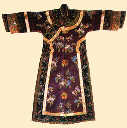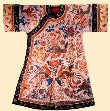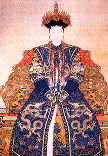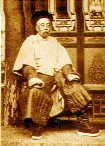 The organization of political power mainly consisted of the rulers of the Manchu ethnic minority in the Qing Dynasty (1644-1911), so the customs of Manchu bannermen affected those of the Central Plains. The traditional dress code that had been handed down for several thousand years was damaged because of the invasion of the Eight Banners soldiers. It might be said that this innovation was another improvement of China's traditional dress code. It was the third obvious revolution after the Mongol Costumes for Arrow Shooting on Horseback and the Open Dresses of the Tang Dynasty in the history.
The organization of political power mainly consisted of the rulers of the Manchu ethnic minority in the Qing Dynasty (1644-1911), so the customs of Manchu bannermen affected those of the Central Plains. The traditional dress code that had been handed down for several thousand years was damaged because of the invasion of the Eight Banners soldiers. It might be said that this innovation was another improvement of China's traditional dress code. It was the third obvious revolution after the Mongol Costumes for Arrow Shooting on Horseback and the Open Dresses of the Tang Dynasty in the history.
SinceQizhuang(costumes of bannermen) were convenient for dressing and cost fewer materials, they replaced the complicated ancient blouses and skirts. This was the main reason that later generations easily accepted the dressing style ofQizhuang.
TheQizhuangof Manchu ethnic minority looked rectangular, and the saddle-shaped collar could cover the cheek and protect the face. The costume had no waistline, and theirU-shaped sleeves with semicircle cuffs could cover the hands. The clothes were decorated with laces and a sleeveless jacket or a mandarin jacket could be worn over a gown. The solemn, respectful and morally lofty appearance ofQizhuangbroke away from tower-shaped clothes and hats. TheQizhuangcostume still has certain impacts on modern costume. Especially, along with the development of China, a cheongsam that demonstrates women's curvaceous beauty has become the representative garment of the Han people, as it can show the femininity and temperament of oriental ladies.
A cheongsam or a short coat had a lute-shaped front, a front with buttons on the right or a front of Chinese-style jacket with buttons down, etc. A skirt or a pair of trousers used to match a cheongsam was decorated with printing, embroidering, oblique seaming and other techniques. Women of Manchu ethnic minority neither bound their feet nor wore skirts. The sleeveless jacket (padded or lined) over the coat was of the same length as the coat, and within it there was a small underwear, which was equivalent to the bellyband worn by women of the Han people.
 Combined Costumes in Different Periods:
Combined Costumes in Different Periods:
 During the reign of Emperor Kangxi, it was very popular for aristocratic women to wear a brown robe with a black collar, and golden round patterns or sheet golden patterns. They also wore adornments in front of their garments, a big wispy bun and a piece of headcloth on their head.
During the reign of Emperor Kangxi, it was very popular for aristocratic women to wear a brown robe with a black collar, and golden round patterns or sheet golden patterns. They also wore adornments in front of their garments, a big wispy bun and a piece of headcloth on their head.
During the Qianlong reign, women wore a big black waistcoat over a buff coat inlaid with pink trims.
During the reigns of Jiaqing and Daoguang, women often wore a purple skirt and a blue upper garment with a low collar.
During the Tongzhi reign, laced ribbons made of blue satin were popular. Such ribbons were more than 3.3 meters long and were decorated with embroidered patterns at both ends. It was a common practice to wear all skirts and trousers with ribbons.
During the mid-term of the Guangxu reign, upper garments and skirts for women gradually became shorter and their sleeves, wider. The ribbons reached beyond the knees for more than a third of one meter. Most clothes were lake blue or pink, and some were aquamarine, bright red and so on.
Upper outer garments of women reached beyond the knees at the end of Guangxu reign. Some skirts were attached with 16 to 20 ribbons, with small silver bells tied at the end of every ribbon. Some gold or silver ornaments such as earpicks, toothpicks and small nippers were hung on the front part of garments.
It was popular to tailor false cuffs, generally 1-2 cuffs or 2-3 cuffs, inside sleeves at the end of the Qing Dynasty. This dressing style not only showed dignity and richness, but also strengthened the close style ofQizhuangcostume.
From the Xuantong reign to the early Republic of China, women's blouses and trousers became smaller and narrower than those at the end of the Guangxu reign, but the saddle-shaped collar became even higher as to cover the whole cheek.
 Women's Costume in the Qing Dynasty
Women's Costume in the Qing Dynasty
 Women's dresses included court, ceremonial and casual costumes. The code of court costume was prescribed as specific dresses for women from the queen to wives or mothers of the seven-rank officials. Ceremonial costume referred to auspicious dresses and mourning apparels. Women's dress for wedding, funeral and birthday were prescribed according to their ranks. Casual costume had various styles.
Women's dresses included court, ceremonial and casual costumes. The code of court costume was prescribed as specific dresses for women from the queen to wives or mothers of the seven-rank officials. Ceremonial costume referred to auspicious dresses and mourning apparels. Women's dress for wedding, funeral and birthday were prescribed according to their ranks. Casual costume had various styles.
There was strict stipulation governing women's daily costume and the dressing styles were bound by laws. It was stipulated that servants, actors and laborers were forbidden to wear clothes made of high-grade materials, such as thread, thin silk, yarn, damask silk, satin, fabric, fine fur, fine wool, cyan materials. What's more, they were untitled to freely use pearl, jade, gold, silver, precious stones and other valuable materials as adornments. Materials of their clothes were limited to ko-hemp cloth, tatting cloth, hirsute, tussah silk, and fur of racoon dog, sheepskin and other low-grade materials.
 Emperess' Court Robes in the Qing Dynasty
Emperess' Court Robes in the Qing Dynasty
 Winter court hats of empress dowagers and empresses were made of fumed marten and sewn with red wefts. Their hats adorned with pearl, gold pheasant patterns, gems and jade ornaments had protective collar behind the neck with drooping bright yellow ribbons. Summer court hats were made of cyan velvet.
Winter court hats of empress dowagers and empresses were made of fumed marten and sewn with red wefts. Their hats adorned with pearl, gold pheasant patterns, gems and jade ornaments had protective collar behind the neck with drooping bright yellow ribbons. Summer court hats were made of cyan velvet.
Empress dowagers, queens and high-ranked imperial concubines used cyan sheets with gold-wrapped metal trims to decorate their court costumes; images of dragons and Chinese charactersFu(blessing) andShou(longevity) were embroidered on the clothes. The winter court robes of empress dowagers, queens and high-ranked imperial concubines were bright yellow, and also decorated with images of dragon patterns. Necklines of dresses of empress dowagers and queens were made of golden filament and decorated with pearls, turquoises and jade ornaments. Three sets of necklaces were hung on the chest when empress dowagers and queens wore court robes. When an empress dowager or queen was in auspicious clothing, she always wore one set of necklace made of pearls, jade and other top-grade materials. Court necklaces of imperial concubines were decorated with ambers, each having 108 beads in four parts divided by three big ones.
 Men's Costume in the Qing Dynasty
Men's Costume in the Qing Dynasty
 Men's costume mainly included long gowns and mandarin jackets, and the sleeve ends employed the horse-hoof shape for the first time. The structure of a long gown was simple, with erect collar and straight main body. Most long gowns had bigger inner piece on the right side. Both back and front parts had seams, and the lower hem might have two splits, four splits or no split.
Men's costume mainly included long gowns and mandarin jackets, and the sleeve ends employed the horse-hoof shape for the first time. The structure of a long gown was simple, with erect collar and straight main body. Most long gowns had bigger inner piece on the right side. Both back and front parts had seams, and the lower hem might have two splits, four splits or no split.
Costume of imperial nobles included long gowns with splits on four sides, facilitating shooting arrow on horseback. Long gowns of common people just had two splits on the left and right sides or had no split. The latter was clothes that people wore during entertainment. Mandarin jackets worn over long gowns did not reach the knees, and sleeves were wider and shorter. It was fashionable to wear ornaments in the Qing Dynasty.
Jackets were the most popular dress among men's costumes, and mandarin jackets were one of the four costumes of Manchu men, namely ceremonial robes, casual gowns, rain jackets and Mandarin jackets fell into several types: unlined single-layer, interlining and cotton. They were usually azurite, dark purple or black. Top-grade mandarin jackets in the Qing Dynasty was the Yellow Mandarin Jacket, which was the highest reward from the emperor and only four types of people were entitled to get it: trusted subordinates of the emperor, ministers who presented rare birds or beasts to the emperor, senior officials with great contribution to war, and court envoys.
Mandarin jackets had either long or short sleeves, which were both loose.
